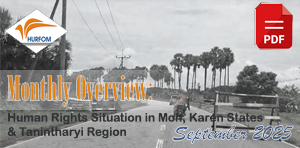Mon State Rice Farmers Awash in High Water and Low Profits
September 3, 2012
HURFOM:An unusually strong monsoon season has pounded the upper and lower areas of Myanmar since July, causing flooding that displaced tens of thousands of people and wreaking havoc on agricultural crops. While farmers struggle to protect their impending harvests from the heavy downpours, they also report the strain of reduced profits and diminished personal savings. Although rice farming has traditionally been the primary occupation in Mon State, some farmers now feel that paddy cultivation no longer presents a viable or sustainable means of support.
According to the Burmese Association of Rice Producers, over 615,000 acres of farmland were underwater in Burma in the mid-monsoon season, although 213,000 acres resurfaced after water levels fell in certain areas. Myanmar’s Department of Meteorology and Hydrology continually issued flood warnings throughout August, and reported that this year’s rainfall represents a significant departure from the country’s thirty-year average.
One farmer in Mon State said the water level on his farm had reached his chest, and explained that if the rice plants remain completely submerged for more than a month, they will die. Of his seven acres of paddy fields, he expects that the majority of the rice crop will be destroyed, but said he can only afford to re-plant about three acres of land. He, like others, is preparing for the financial hit caused by reduced yields, loss of profit, and extra costs.
In addition to above-average rainfall, rice farmers encounter growing debt burdens and unfair trading practices by middlemen. Local farmers can no longer depend on profits to invest into their businesses, having to dip into their savings to continue or expand cultivation. Unable to afford hired laborers and, this year, possibly needing to plant crops again after the flooding devastates paddy fields, many farmers claim to work harder on their farms now than they had to before.
Nai Naing Oo, a local farmer from Bal-dow village, said, “Facing debts, farmland owners—the employers themselves—now have to labor on their own farms. The price of rice [they get] is also not good. And, since they have to pay hired farm workers with their personal savings, by the time the rice is harvested and stored, they only have enough rice to feed their own families.”
A rice trading association in Mon State currently lists the price of rice at around 1,030 Kyat per kilogram, but farmers report that traders, or “brokers,” rarely adhere to established prices, paying lower-than-market rates and then selling the rice to merchants for a tidy profit.
Local farmer Nai Thein Htun from Pa-nga village said, “We are now working on our farm only to get enough rice for our family to use. If we look at farmland in this area, one acre can produce about 50 tin of rice [22.5 kilograms]. Rubber-tapping workers only need to work for one month to earn that amount of money.”
According to another local farmer, “On top of heavy rains, the government does not properly aid farmers despite the fact that the new government’s policies are changing toward democracy. Although the government said it would provide fertilizer at low costs, the price we have to pay for a sack of fertilizer [produced by the government] is not so different from one we buy at the store. A sack of government fertilizer costs 19,000 Kyat, while store-bought fertilizer costs 23,000 Kyat. In northern Mudon Township, which is governed by U Soe Myint, the farmers have more difficulty than those in southern Mudon Township because U Soe Myint does not act on behalf of the farmers. Although he ordered the [village level] administrators to help the farmers, they do not.”
Finally, while the reluctance to rice cultivation has grown among some farmers, the Farmland Law enacted in March 2012 by the Union Parliament restricts farmers’ ability to shift to a new crop or swiftly respond to changing economic incentives. Under section 3 (d) of the new bill, officially titled the Pyi Daung Su Hluttaw Law No. 11, “the State is the ultimate owner of all land and thus farmland is provided to develop agricultural products in accordance with prescribed conditions.” Once land has been designated as “farmland” by the government, it must be used for that purpose or it becomes vulnerable to confiscation. Section 12 (g) states that, “farmland shall not be used for any other means without permission,” and farmers who cannot afford to or no longer profit from cultivating their land feel forced to continue regardless of the benefits they receive.
Once the monsoon rains let up and paddy fields emerge from the floods, farmers will have to make difficult decisions regarding whether to plant replacement crops, potentially shouldering new debt in the process, or cut their losses and wait for the next harvest season.
Comments
Got something to say?
You must be logged in to post a comment.



















































